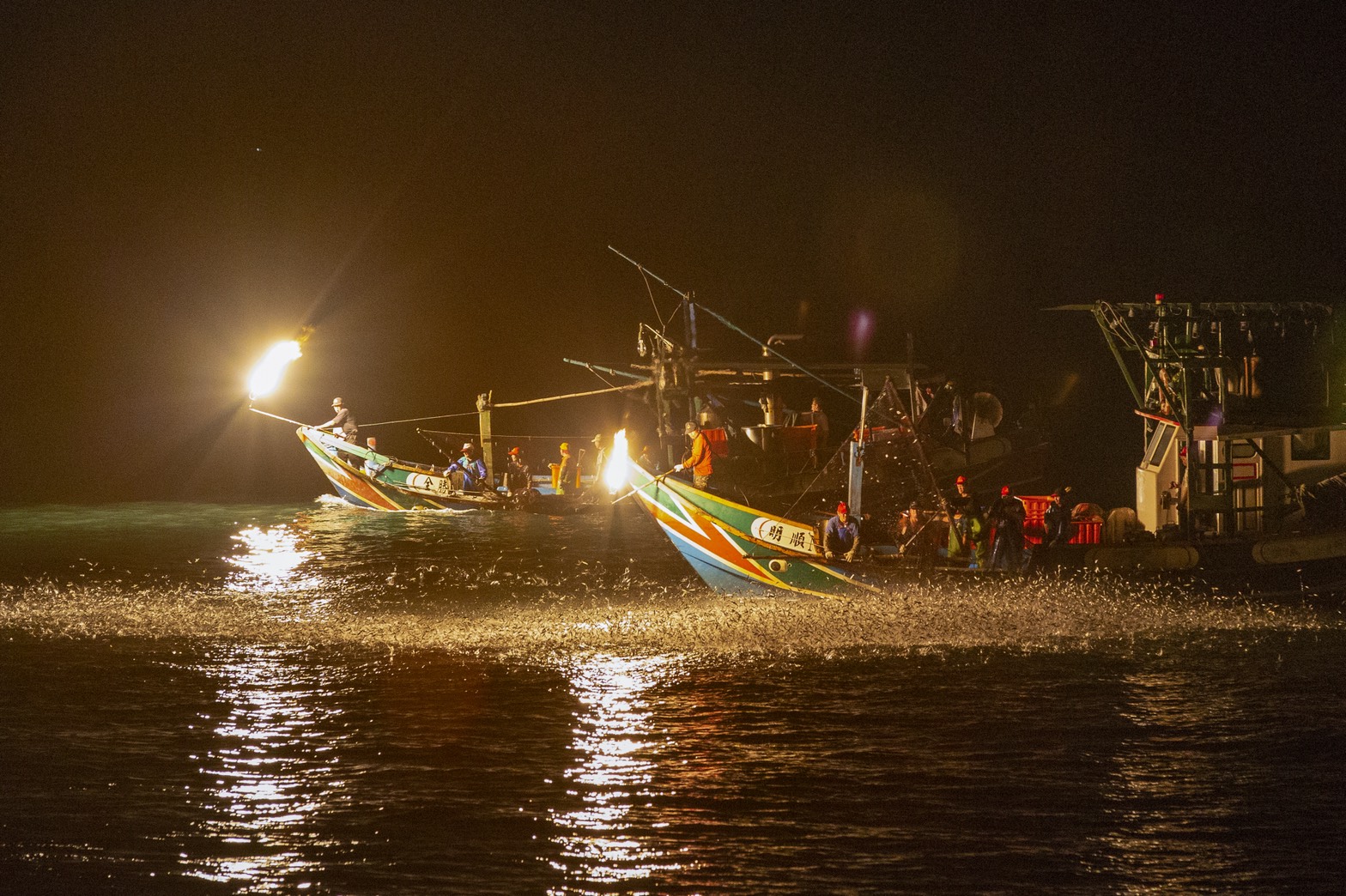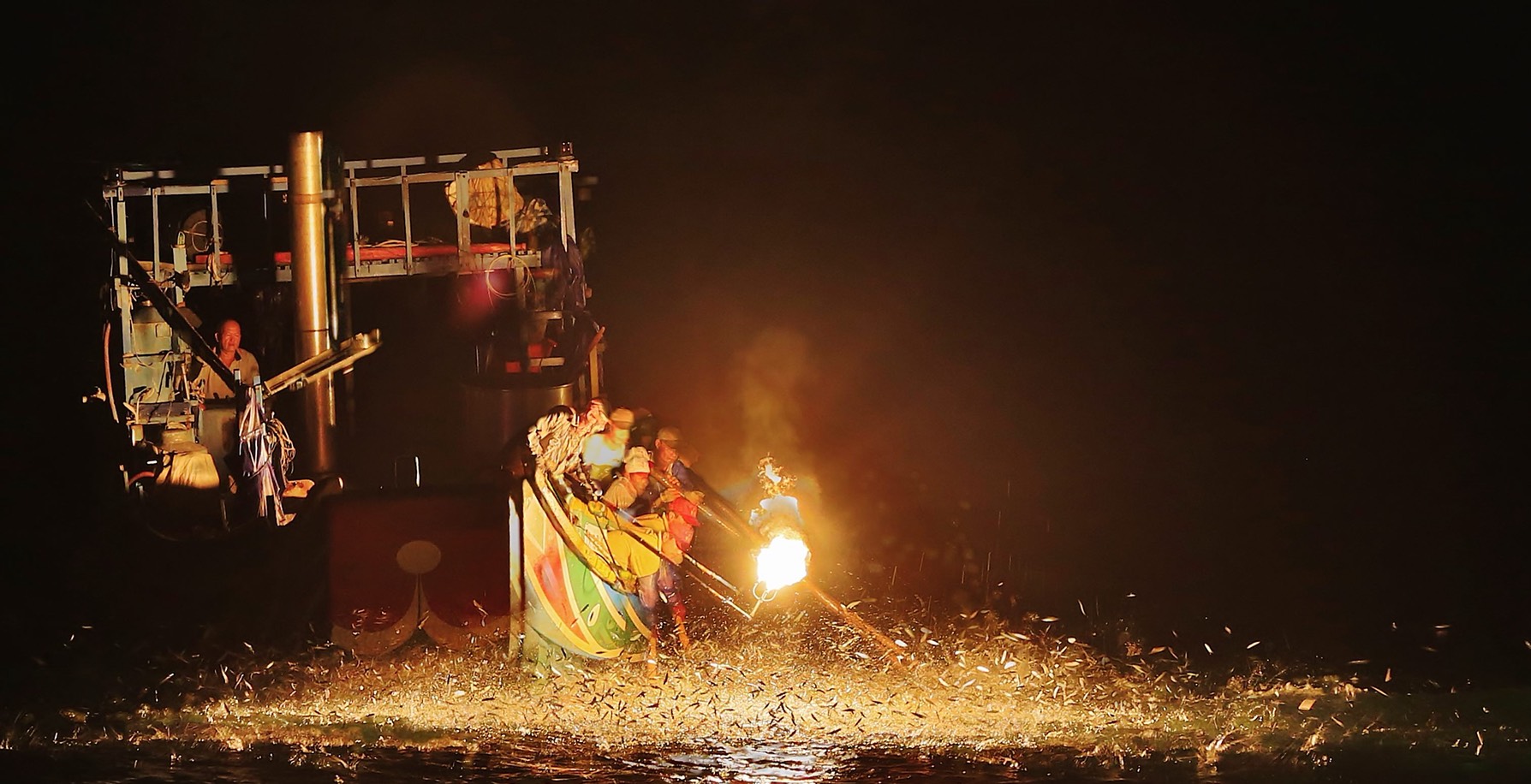

文、圖:新北市野柳國小 張錦霞校長
![]()
新北市擁有全國最長的海岸線,在海洋教育的推動上匯聚國內外關注的議題和專家學者的意見,透過團隊的創新規劃,在海洋教育的課程實作和體驗宣導上紮根領航,與世界潮流同步接軌,引領教育關注整體海洋生態環境和永續實踐海洋綠活。
野柳國小位居北海岸線上,學校面對東海,緊鄰世界著名的野柳地質公園,學區中豐富的海洋生態、漁村文化和海岸地形地質景觀等,造就了野柳國小海洋教育課程的多元特色發展,而近幾年因食農教育的推動,也帶動大家關注海食教育。野柳國小為新北市海洋教育重點推動學校,又有環境地利之便,因而被賦予海食教育體驗探索的推廣執行,善用社區總體營造資源,讓親師生結合生活經驗在情境式的互動學習中,了解海食教育的重要性,並回歸到生活中實踐。以下將從學校結合學區的海洋資源來介紹北海岸推動的海食教育課程。

![]()
「蓴」金打造校本特色課程~潮間帶「藻」樂趣
每年2月至4月是北海岸綠石蓴的生長季,從維納斯海岸的潮間帶蔓延至老梅著名的綠石槽,除了吸睛的美景,在地人認為是沒有什麼經濟價值的海藻,早期還多到是堵塞排水管的垃圾,但近幾年因為氣候變遷或者是海洋汙染的影響,石蓴已不復盛況,常剛見蹤跡,很快地就產生白化現象。野柳國小以石蓴為校訂特色課程主題,主要是希望透過生活中常見且容易接觸的石蓴來激盪出學生對海洋生態多樣性和環境的關注,轉化偏重在石花凍製作的舊有課程,讓孩子觀察海洋環境的改變,探究野柳岬的髮菜、石花和石蓴等藻類逐漸減少的原因,也結合在地海洋文化的溯源,訪談海女採集石花的故事,讓學生能深刻的感受海洋與生活的連結,翻轉石蓴是生態環境的重要指標,也研發石蓴、石花與各類海藻的健康美食,讓孩子比較海藻與陸上蔬菜的異同,重新發現海食教育的新契機。

慢魚運動種子教師培訓工作坊
實踐是教育轉變的契機,而老師則是搭建行動鷹架的推手,所以我們期待具備敏銳度的海洋教育覺知者,當臺灣餐廳不斷的創造鮪魚、翻車魚、小卷和螃蟹等的銷售奇蹟時,我們看見海鮮王國的義大利正努力的推廣慢魚運動,推動者馬蘭戈尼讓大家關心海洋生態,從知魚、懂魚、會說魚故事,拉近我們與生活海食的距離,呼籲吃在地、吃當季,能海洋存本慢慢吃魚。所以我們每年辦理慢魚運動種子教師培訓工作坊,邀聘專家學者來指導老師了解海洋生態的食物鏈,透過遊戲式的體驗操作課程和漁村走讀,讓老師有感,也結合海科館的創意教具和教材研發,讓老師能在各領域課程設計中融入海食教育的議題,讓學生從小具備慢魚運動的思維與生活實踐。
![]()
里山里海親子海食教育體驗營
海食教育的推動,需要教育合夥人-家長的支持與參與,學校利用暑假時間辦理里山里海親子海食教育體驗營,讓新北市親子攜手走讀海洋教育,結合產地的漁業資源和周邊的海洋生態環境,讓親子一同來體驗學習慢魚運動。活動從紙上海鮮餐廳展開學習,透過各式的海鮮圖卡,讓親子先了解如何選購合宜的海鮮,才能讓海洋存本永續生態;再操作體驗石蓴討海麵,一邊聆聽漁民討海飯的意義,一邊品嘗海邊的創意特色料理;也實際到港邊漁船採買當季新鮮的海食和親子共同烹煮創意料理;傍晚則踩踏最美麗的維納斯海岸,和在地老師一起探索潮間帶生態,發現大海的奧秘。希望透過豐富的海洋文化學習活動,讓親子感受海洋的生命力,也企盼讓海洋教育從小紮根,推廣珍惜海洋生態和文化,而不是吃到飽的海鮮文化。
海食教育慢魚運動討海飯薪傳
每年6月在野柳的海王星碼頭會舉辦畢業生的獨木舟薪傳,是媒體關注的焦點,所以學校會特別經營海洋教育的主題重點行銷,結合在地文化的環保弄輦、討海感恩飯、海女薪傳、新船入港灑麻糬等,為海洋文化注入新的生命,感恩與大海搏鬥討生活的漁民,也感恩大海的恩賜。另亦有結合海洋生態的九孔放流、石蓴公主和慢魚運動等,呼籲大家要海洋存本,永續海洋資源。也希望帶動社區和親師生關注海洋生態,適量捕捉慢慢吃魚,珍惜海洋資源。當然,在推廣慢魚運動的同時,我們也結合世界海洋日,呼籲社會大眾重視海洋汙染和海洋廢棄物的議題,也讓親師生以行動展現聯合淨灘和生活減塑的實踐,讓大家擁有安全且安心的海洋環境和豐富海食。
![]()
萬里螃蟹季的生態捕抓法
金山磺火季的閃耀蹦火仔
「蹦火仔」是北海岸地區的古老捕魚方式,目前則僅存於金山磺港地區,相傳源自於巴賽族的原住民捕魚技法,主要是運用硫磺石(碳化鈣)加水而產生乙炔易燃氣體,再由船上擔任「火長」的人員以火把或電土點燃,瞬間會產生巨大聲響和強大的火光,吸引趨光性的青鱗魚等跳耀聚集,漁民再以叉手網來捕撈,是匯聚先民捕魚的智慧技巧,也彰顯在地的海洋文化特色。這是金山地區每年5月至9月因為洄游性的青鱗魚聚集而採用的夜間捕魚方式,這種珍貴的海洋文化紀錄-磺火捕魚法,目前已列入新北市文化資產的保護,在野柳國小的漁事文化館就有展示磺火捕魚資料,學校的學生會擔任解說員來介紹說明。而青鱗魚盛產季節,也吸引不少饕客造訪金山附近的餐廳,品嘗鮮美的海滋味。(下圖為鄭進仁醫師提供)
 |
 |
 |
北海岸的牽罟捕魚樂
靠海的漁民對於魚群的匯聚有著超凡的敏銳度,對於捕魚的方式也因為環境而有不一樣的技法,在野柳和金山附近的牽罟(地曳網),就是先民早期善用平緩沙灘所發明的捕魚方法,靠著居民的團隊合作來捕魚。這種捕魚技法是透過「吹罟螺」來通知居民魚群浮現,號召大家一起來以舢舨船(罟仔船)和拋撒魚網來圍捕魚群。在牽罟捕魚作業時,罟網的一端要先固定在岸邊的木樁上,再由罟仔船載著罟網出海,繞著魚群順序下網,約繞半圈船再划回岸邊,將罟網的另一端交給岸邊的人,等魚群都趕進網中,留在岸邊的人再腰纏短繩,兩端合力拉繩,將漁網拉上岸,而凡是參與牽罟捕魚的人皆能分到所捕的漁貨。現在這種耗時費力的捕魚法已不被漁民使用,純粹是讓大家體驗早期的捕魚生活方式,一種溯源感恩的情感回饋。
(下圖為瑪鋉協會和顏端佑老師提供)
其實在臺灣各地還保存著許多早期的海食紀錄,這些歷史的軌跡引領著我們要珍惜海洋資源,要合乎大自然的取用法則,尊重自然。在海食教育的推動中,我們深信撒下的每一顆保育種子,都能關注海洋生態的永續,為海洋存本,成為維護海洋環境的綠活實踐者。
Marine Food Education, Slow Fishing and the Fun of Seaweeds![]()
Principal C.H.Chang of Yehliu Primary School
Translated by Translated by Kaifu Chang
New Taipei City has the
longest coastline among domestic cities in Taiwan. When
promoting marine education, we have the advantages of insights
from related experts, therefore can focus on attention-drawing
issues. With innovative designing from professional groups, we
look forward to piloting the practicing and experiencing of
local marine education. Furthermore, we would like to link that
to the world trends and draw the educational attention to marine
biology environment and sustainable marine green life.
Yehliu Primary School sits on the northern coastline, facing the
East Sea, next to the world well-known Yehliu Geopark. The rich
marine biology, fishing village culture and coastline
geographical landscapes have shaped the characteristics of
Yehliu Primary School marine education.
Recently,
owing to the promoting of food and agriculture education, the
marine food education has been getting more and more attention.
Yehliu Primary School, as a key school of marine education with
environmental convenience, has been granted the responsibility
of promoting and practicing marine food education. The following
is the introduction of marine education promoted in northern
coastline from angles of combining school and community
resources.
Sea Lettuces the Fun of Seaweeds in the
Intertidal Zone
The growing season of sea
lettuces starts from every February to April. Apart from the
eye-catching scenery, the plants were considered nothing worthy,
but troublesome trash which may stuck the pipes in early times.
Recently, because of climate change or ocean pollution, they are
no longer easy to see. Once the sea lettuces grow, they soon get
bleached. The sea lettuces were enlisted in the school-designed
curriculum making students’ aware of the marine biology
diversity and the environment as well as trying to identify the
reason of their decreasing number. Meanwhile, integrating the
tracing of local culture orientation and interviews of female
divers into courses make students’ life experience deeply
interwoven with ocean. The sea lettuces are the important
biological indicators. We also developed various kinds of
delicacies from seaweeds. Students can differentiate seaweed
foods from those vegetables grown on land and rediscover the new
turning points of marine food education.
Slow
Fishing Teacher Workshop
Practicing is the
turning point of education. Teachers are the architects since
scaffolding of the building called education. Hopefully, we
anticipate teachers can develop sharp sensitivity toward marine
education in the future. As selling number of seafood in Taiwan
restaurants getting higher, Italy, known as a seafood kingdom
has been trying hard to promote Slow Fish Movement. From knowing
fish, understanding fish, telling stories about fish, we are
getting close to these local and seasonal seafood. As a result,
we hold Slow Fish teacher workshop every year. Related experts
are invited to guide participants to understand the food chain
of marine biology. Through experiencing and non-residential
courses, teachers are getting more involved. Combining with the
creative teaching aids and instruments from National Museum of
Marine Science and Technology, teachers can integrate marine
food education into each curriculum design to make students
aware of Slow Fish since they are young.
Satoyama
and Satoumi, the Parent-kid Marine Food Education Experiencing
Camp
It takes educational partners, the
parents’ support and involvement to promote marine food
education. Our school hold Satoyama Satoumi, the parent-kid
marine food education experiencing camp during summer vacations.
This camp aims to offer non-residential courses combing local
fishing resources and adjacent marine biological environment for
both parents and kids to learn the so-called Slow Fishing. The
activities began from a seafood restaurant board game to let
participants know how to buy proper seafood making the ocean
sustainable. Next, the participants made noodles from the sea
lettuces while listening to the fishermen’s explanation to local
seafood. They also visited the fishing harbor to buy seafood in
season. In the evening, they explored the intertidal zone with
teachers to discover the secrets of nature. We hope to make the
participants feel the vitality of the ocean through these marine
education activities. Marine education should start while the
students are young. We should emphasize the valuable marine
culture and biology rather than merely focus on seafood.
Slow Fishing
The graduation ceremony
is held every June at the Neptune Pier which is also a mass
media focus. Marine education combined with local culture is
definitely broacasted and marketed. In addition, there are also
activities like abalones releasing, Sea Lettuce Princess Pageant
and slow fishing trying to draw people’s attention to the
sustainability of ocean. We also hope to make people pay more
attention to marine biology, slow fishing and marine resources.
World Oceans Day emphasizing dealing the problems of marine
pollution and waste is an important issue for us as well. By
practicing beach clean-up and being plasticarians, we would like
to make our marine environment safer and seafood everlasting.
Eco-Crabbing in Wanli Crab Seasons
Autumns are the harvest seasons of fat crabs. Talking about
Wanli, people cannot ignore the famous carbs. During carb
harvest seasons, carb cages are piled here and there by the
fishing harbor awaiting to catch crabs. Instead of old methods,
carb fishermen in Wanli use eco-crabbing ways to catch crabs
which can prevent the carbs from being injured during catching
and make the marine resources balanced. Wanli Crabs are mainly
the Flower Crabs, the 3-Spot Crabs, and the Stone Crabs. Female
crabs with eggs or crabs under the size of 8-6 cm in length are
not allowed to catch during crab seasons. Only by making the
fishery industry sustainable can we have the chance to enjoy
these seafood delicacies. Proper seafood and everlasting marine
culture can be attained through sound seafood education.
Sulfuric Fire Fishing in Jinshan
Sulfuric Fire Fishing is an ancient fishing way inherited from
aboriginal people which remains being used in Huanggang Fishing
Harbor. Sulfuric fire was lit to catch scaled sardines. Not only
the ancient wisdom of our forefathers but also the local marine
culture were demonstrated. Taking place from May to September
every year, the precious Sulfuric Fire Fishing is now one of the
cultural heritages in New Taipei City. In Yehliu Primary School,
some of our students are trained to introduce the Sulfuric Fire
Fishing. Also, many gourmets flood to Jinshan area to have
seafood during scaled sardines seasons.
Beach Seine
Fishing in Northeast Coast
Fishermen have
their sensitivity in catching fish. The ways of fishing differ
from place to place. Beach Seine Fishing was invented in Yehliu
and Jinshan areas in early times taking advantage of sand
beaches and residences cooperation. After sounding a horn to get
everyone’s attention, sampans sailed out throwing cast nets to
catch fish, while people on shore pulling back the net when
there is fish in. Anyone who has took part in this fishing can
share the harvest together. However, this fishing method is no
longer used.
There are still many documents about seafood in
Taiwan. These historical tacks lead us to cherish marine
resources. We should respect nature. When promoting seafood
education, we firmly believe that every seed can turn out to be
a marine environment protector in the future.